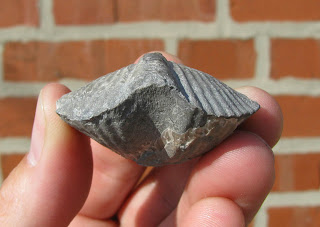This is a specimen from the Montebello sandstone member of the Mahantango and was found at Ft. Hunter, PA. It's an internal mold of the Brachial valve and you can see just a hint of shell material near the upper edge. The muscle scars are the outstanding feature of the shell as you can see the prototypical triangular shape where the pedicle muscles were attached and the stippled areas where the hinge muscles were attached. You can also see some fine ribs radiating out from the hinge of the shell. As this is an internal mold I would assume they were an internal feature as well as an external decoration.



This next specimen is from the Sherman Creek member of the Mahantango at Seven Stars, PA. It's not as complete as the prior specimen, but still shows the same muscle scars. Above it you can see a mystery shell which I used to call Devonochonetes but I am unsure of this ID anymore.

Protoleptostrophia is a member of the extinct Strophomenida order of Brachiopods and is concurrent with fellow members Strophodonta and Leptaena. While Protoleptostrophia is confined to the Devonian, the order existed from the Ordovician up into the Triassic before becoming extinct at the Triassic-Jurassic boundary. I've collected some of it's common ancestors from the Ordovician while in the Cincinnati area: Strophomena and Rafinesquina.






























































